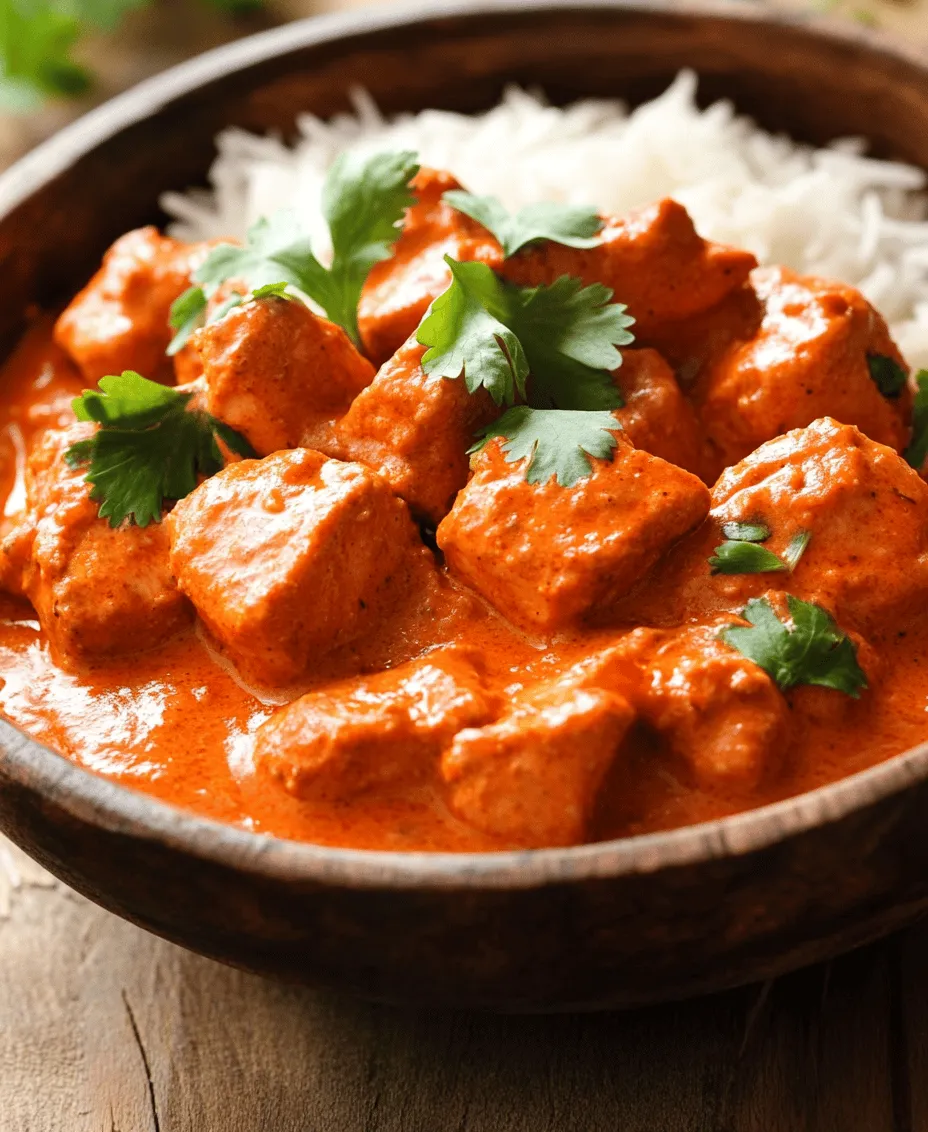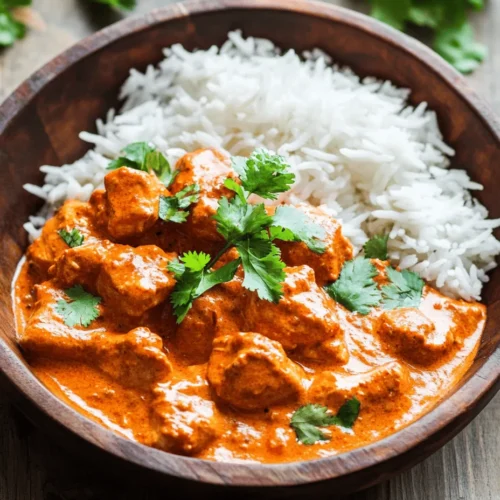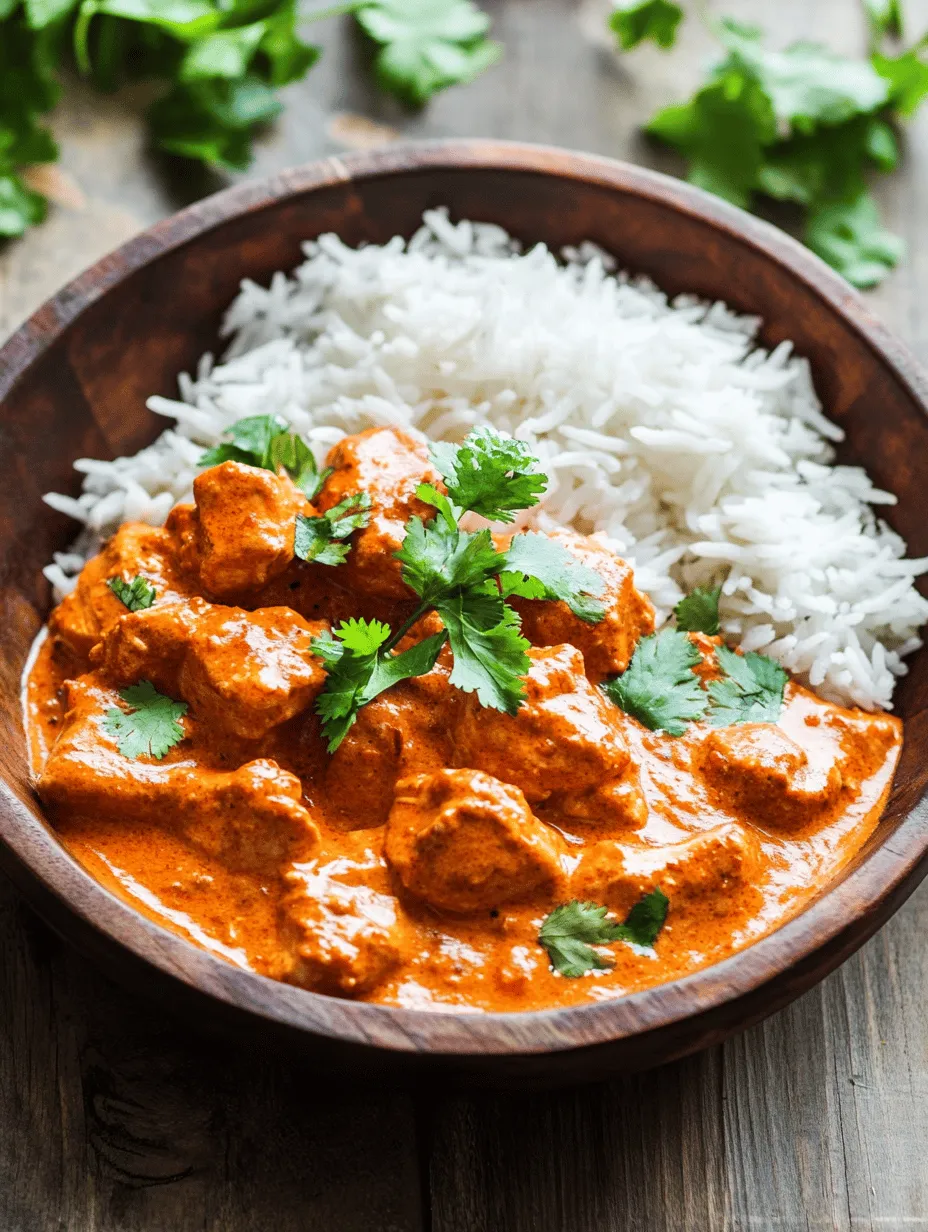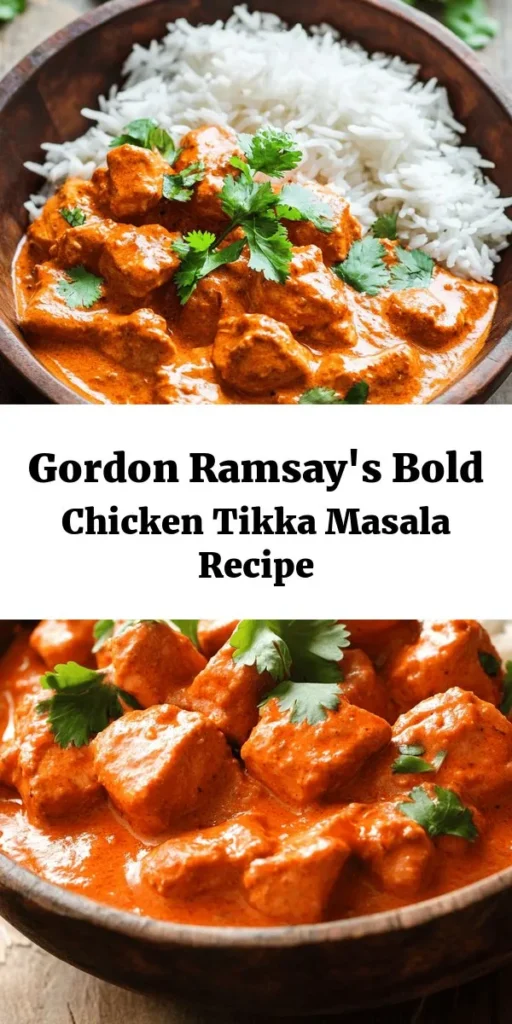Introduction
If you’ve ever dined at an Indian restaurant or indulged in a takeaway, chances are you’ve come across Chicken Tikka Masala, a dish that has transcended cultural boundaries to become a beloved staple in global cuisine. This flavorful curry, featuring succulent pieces of marinated chicken simmered in a rich and creamy tomato sauce, has garnered popularity not only in India but also across Europe, North America, and beyond. Its vibrant colors and aromatic spices make it a feast for both the eyes and the palate.
Among the many interpretations of this classic dish, Gordon Ramsay’s Chicken Tikka Masala stands out for its authenticity and depth of flavor. The renowned chef and television personality has put his unique spin on the traditional recipe, ensuring that it matches the bold tastes and textures that make Chicken Tikka Masala so irresistible. In this article, we will explore Ramsay’s take on this iconic dish, delving into its origins, cultural significance, and the essential ingredients that contribute to its deliciousness. We will also provide detailed preparation steps to guide you on your culinary journey.
Understanding the nuances of the ingredients and techniques used in Gordon Ramsay’s Chicken Tikka Masala is crucial for anyone wishing to recreate this dish in their own kitchen. From the marination process to the spices that bring the dish to life, each element plays a vital role in achieving that authentic taste that food lovers crave. So, let’s embark on this flavorful adventure and unlock the secrets to making a restaurant-quality Chicken Tikka Masala at home.
Understanding Chicken Tikka Masala
The origins of Chicken Tikka Masala are as rich and complex as its flavor profile. While the dish is often associated with Indian cuisine, its exact beginnings are the subject of much debate. Some culinary historians argue that Chicken Tikka Masala was born in India, while others assert that it was actually created by South Asian immigrants in the United Kingdom. Regardless of its origins, the dish has become a symbol of cultural fusion, representing the blending of Indian and British culinary traditions.
Cultural significance aside, Chicken Tikka Masala has evolved into a versatile dish with numerous variations. Different regions and chefs have put their own spin on the recipe, leading to a wide array of flavors and textures. For instance, some versions feature a sweeter sauce, while others are more heavily spiced. The beauty of Chicken Tikka Masala lies in its adaptability, allowing home cooks and professional chefs alike to experiment with ingredients while maintaining the essence of the dish.
Whether enjoyed as a comforting home-cooked meal or served as a centerpiece in fine dining establishments, Chicken Tikka Masala has broad appeal. Its enticing aroma and harmonious blend of spices make it a favorite for those seeking a taste of India, while its creamy sauce and tender chicken can win over even the most discerning palates. It’s a dish that invites people to gather around the table, fostering a sense of community and shared experience.
Ingredients Breakdown
Creating an exceptional Chicken Tikka Masala begins with selecting high-quality ingredients. Understanding the purpose of each component in the recipe is essential for achieving the authentic flavors that define this dish. Below, we break down the key ingredients used in Gordon Ramsay’s version of Chicken Tikka Masala and explain their roles in crafting a memorable meal.
Chicken Thighs
For this recipe, boneless chicken thighs are the preferred choice. Unlike chicken breasts, which can easily dry out, thighs remain juicy and tender during cooking. The higher fat content in chicken thighs not only enhances the flavor but also contributes to a more satisfying texture. Using boneless meat simplifies the cooking process, allowing for even marination and cooking without the need to debone the chicken.
Yogurt
Yogurt plays a crucial role in marinating the chicken, serving as both a tenderizer and a flavor enhancer. The acidity in yogurt helps break down the proteins in the chicken, resulting in tender, succulent pieces that soak up the spices. Additionally, yogurt adds a subtle tanginess that balances the richness of the cream and the spices in the sauce. Allowing the chicken to marinate for several hours—or preferably overnight—ensures that the flavors penetrate deeply, resulting in a more flavorful dish.
Spices
A hallmark of Chicken Tikka Masala is its complex blend of spices, each contributing distinct flavors that elevate the dish. Here are the key spices used in Ramsay’s recipe:
– Garam Masala: This quintessential Indian spice blend consists of a variety of spices, including cardamom, cinnamon, cloves, and nutmeg. Garam masala adds warmth and depth, giving the dish its characteristic aroma.
– Cumin: Earthy and nutty, cumin enhances the overall flavor profile of the dish. Its distinctive taste pairs well with the other spices, contributing to the savory complexity of the sauce.
– Coriander: With its bright and citrusy notes, coriander adds freshness to the dish. Ground coriander is often used in the marinade, while whole seeds can be toasted to release their essential oils and added to the sauce.
– Turmeric: Known for its vibrant yellow color, turmeric imparts a warm earthiness to the dish. It also provides health benefits, including anti-inflammatory properties, making it a popular choice in Indian cooking.
– Paprika: Paprika adds a mild sweetness and a hint of smokiness to the Chicken Tikka Masala. Depending on the variety used, it can also impart a vibrant red hue to the sauce.
Heavy Cream
To achieve the creamy texture that Chicken Tikka Masala is famous for, heavy cream is essential. It balances the spices’ heat and acidity, resulting in a rich, velvety sauce that coats the chicken beautifully. Heavy cream also enhances the dish’s indulgent quality, making it a comforting meal perfect for any occasion.
Fresh Cilantro
As a finishing touch, fresh cilantro is often used as a garnish for Chicken Tikka Masala. Its vibrant green leaves not only provide a burst of color but also add a refreshing note that brightens the overall flavor. Cilantro complements the spices and cream, bringing harmony to the dish while enhancing its visual appeal.
Preparation Steps
With a solid understanding of the ingredients, we can now delve into the crucial preparation steps that will set the foundation for Gordon Ramsay’s Chicken Tikka Masala. The first and most important step is marinating the chicken, which significantly impacts the final dish’s flavor and texture.
Marinating the Chicken
1. Prepare the Marinade: In a large mixing bowl, combine plain yogurt with a blend of spices—garam masala, cumin, coriander, turmeric, and paprika. Add salt to taste, ensuring that the seasoning is well-balanced. This marinade is what will infuse the chicken with flavor.
2. Add the Chicken: Cut the boneless chicken thighs into bite-sized pieces and add them to the marinade. Mix well, ensuring that each piece of chicken is thoroughly coated. The yogurt will cling to the chicken, allowing the spices to adhere effectively.
3. Marination Time: Cover the bowl with plastic wrap or a lid and refrigerate. The marination time is critical; ideally, allow the chicken to marinate for at least 4 hours, but overnight is recommended for optimal flavor penetration. The longer the chicken sits in the marinade, the more tender and flavorful it will become.
4. Preheat the Grill or Oven: About 30 minutes before you plan to cook the chicken, preheat your grill or oven. If grilling, ensure your grill is hot and ready to create a nice char on the chicken. If using an oven, set it to a high temperature to mimic the intense heat of a tandoor (traditional clay oven) used in Indian cooking.
As you prepare to cook the marinated chicken, remember that the process of marination is not just about flavor—it’s also about texture. The yogurt’s enzymes will help break down the meat fibers, ensuring that each piece of chicken remains juicy and tender throughout the cooking process.
In the following sections of our article, we will explore the steps for cooking the chicken and preparing the sauce, guiding you toward creating a delicious Chicken Tikka Masala worthy of Gordon Ramsay’s kitchen. Stay tuned as we dive deeper into the intricacies of this beloved dish.

Tips for Achieving the Right Consistency in the Marinade
Creating a perfect Chicken Tikka Masala starts with the marinade, which is crucial for infusing flavor and tenderness into the chicken. To achieve the right consistency in your marinade, it’s essential to balance the dry and wet ingredients.
1. Yogurt Base: Use full-fat yogurt as it not only helps in tenderizing the chicken but also provides a creamy texture. Ideally, the yogurt should be thick; if it’s too runny, it can dilute the spices and flavors. Strain the yogurt through a cheesecloth or a fine sieve for a few hours if necessary.
2. Spice Integration: Combine your spices into the yogurt before adding it to the chicken. Make sure they’re well-blended; this ensures that every piece of chicken is evenly coated.
3. Oil Addition: A tablespoon or two of vegetable oil or ghee can help achieve a silky smooth consistency. It also aids in better browning during cooking.
4. Adjusting Thickness: If your marinade seems too thick, add a splash of water or lemon juice gradually until it reaches a pourable consistency. Keep in mind that it should be thick enough to cling to the chicken without dripping off.
By following these tips, you’ll create a marinade that enhances the chicken’s flavor and ensures it remains juicy and tender during cooking.
Cooking the Chicken: Techniques for Browning and Ensuring Moisture Retention
Once the chicken has marinated for at least a few hours (or preferably overnight), it’s time to cook it. Proper cooking techniques are essential for achieving that delicious golden-brown color while retaining moisture.
1. High Heat Searing: Use a high heat when searing the marinated chicken. This technique helps in caramelizing the sugars in the marinade, providing that characteristic smoky flavor. Preheat your pan or grill on medium-high heat before adding the chicken.
2. Cooking in Batches: Avoid overcrowding the pan. When too many pieces are in the pan at once, the temperature drops, leading to steaming rather than searing. Cook the chicken in batches, allowing each piece enough space to brown properly.
3. Using a Meat Thermometer: To ensure the chicken is cooked through while still being juicy, use a meat thermometer. The internal temperature should reach 165°F (75°C). Remove the chicken from the heat just before it hits this temperature, as it will continue to cook slightly due to carryover heat.
4. Resting Period: After cooking, let the chicken rest for about 5-10 minutes before cutting. This allows the juices to redistribute throughout the meat, maintaining moisture.
By employing these techniques, you’ll have beautifully browned chicken pieces that are tender and full of flavor.
Tips on Managing Heat Levels to Avoid Overcooking
Managing heat levels is critical in ensuring that your Chicken Tikka Masala doesn’t end up dry or overcooked. Here are some effective tips:
1. Use Moderate Heat for Simmering: While searing the chicken requires high heat, reduce the heat to medium or medium-low when adding it to the sauce. This allows the chicken to cook through without becoming tough.
2. Monitor Cooking Time: Keep a close eye on the cooking time, particularly during the simmering phase. Chicken pieces generally take about 15-20 minutes to cook in the sauce, depending on their size.
3. Frequent Stirring: Stir the sauce regularly to prevent it from sticking to the bottom of the pan, which can cause burning. This also helps in evenly distributing heat throughout the dish.
4. Taste Testing: Always taste your dish as it cooks. This not only helps you gauge seasoning but also allows you to check for doneness. If the chicken is still tough, give it a few more minutes in the sauce.
By carefully managing heat levels, you can ensure that your chicken remains juicy and tender while being fully cooked.
Making the Sauce: Step-by-Step Guide on Sautéing Onions and Cooking Tomatoes
The sauce is what brings Chicken Tikka Masala to life. Here’s a step-by-step guide on how to create a rich and flavorful sauce:
1. Sautéing Onions: Heat oil or ghee in a large saucepan over medium heat. Add finely chopped onions and sauté until they become soft and translucent, about 5-7 minutes. Avoid browning them too much as this can lead to a bitter taste.
2. Adding Garlic and Ginger: Once the onions are soft, add minced garlic and ginger. Sauté for an additional 2-3 minutes until fragrant. This combination forms the aromatic base for your sauce.
3. Incorporating Tomatoes: Add diced tomatoes (fresh or canned) to the pan. If using fresh tomatoes, blanch them first to remove the skins for a smoother sauce.
4. Cooking the Tomatoes: Allow the tomatoes to cook down for about 10-15 minutes. Stir occasionally to prevent sticking. This step is crucial as it helps to break down the tomatoes, releasing their natural sweetness and acidity.
5. Blending: For a smoother sauce, you can blend the mixture using an immersion blender or transfer it to a regular blender. Blend until you achieve your desired consistency.
By following these steps, you can create a robust sauce that is the backbone of Chicken Tikka Masala.
Importance of Reducing the Sauce for Flavor Intensity
Reducing the sauce is an essential step in developing a deeper, more concentrated flavor. Here’s why it matters:
1. Concentration of Flavors: As the sauce simmers, excess water evaporates, allowing the flavors to intensify. This process enhances the taste of the spices and the sweetness of the tomatoes, resulting in a more robust flavor profile.
2. Adjusting Consistency: Reducing the sauce also helps achieve the desired thickness. A thicker sauce clings better to the chicken and enhances the overall mouthfeel of the dish.
3. Balancing Acidity: If the sauce is too acidic, reducing it can help balance the flavors. The sugars in the tomatoes caramelize during reduction, which can offset the acidity.
To effectively reduce the sauce, let it simmer uncovered for a while, stirring occasionally. You’ll know it’s ready when it coats the back of a spoon.
Combining Chicken and Sauce: Techniques for Melding Flavors
To create the perfect Chicken Tikka Masala, combining the chicken and sauce requires finesse. Here’s how to do it:
1. Adding Chicken to the Sauce: Once your sauce has reached the right consistency and flavor, add the browned chicken pieces. Stir gently to coat each piece with the sauce.
2. Simmering Together: Let the chicken simmer in the sauce for an additional 10-15 minutes. This step allows the chicken to absorb the flavors of the sauce while also ensuring that it finishes cooking through.
3. Final Seasoning: Taste the dish before serving and adjust seasoning as needed. You might want to add more salt, pepper, or even a splash of cream for richness.
4. Garnishing: Just before serving, stir in fresh cilantro for a pop of color and freshness. This not only enhances the visual appeal but also adds a fragrant note to the dish.
By following these techniques, you’ll create a harmonious blend of chicken and sauce that defines Chicken Tikka Masala.
Discussing the Simmering Process and Its Effects on Texture and Taste
The simmering stage is where the magic happens in Chicken Tikka Masala. Here’s what to consider:
1. Flavor Development: Simmering allows the spices to meld together, creating a unified flavor profile. The longer you let it simmer, the more pronounced the spices will become.
2. Texture Transformation: As the chicken simmers in the sauce, it becomes tender and juicy, absorbing the flavors from the sauce. The sauce, in turn, thickens and gains a velvety texture that coats the chicken beautifully.
3. Temperature Control: Maintain a gentle simmer rather than a rolling boil. This ensures the chicken cooks evenly without becoming tough or rubbery.
4. Time Matters: While a quick simmer can work, giving it time to meld (20-30 minutes) often results in a more complex flavor.
By being mindful of the simmering process, you can elevate your Chicken Tikka Masala to a restaurant-quality dish.
Serving Suggestions
Chicken Tikka Masala is best enjoyed with a variety of accompaniments that enhance the meal experience. Here are some traditional and creative serving suggestions:
Traditional Accompaniments: Basmati Rice vs. Naan Bread
1. Basmati Rice: Fluffy basmati rice is a classic pairing. Its long grains and subtle aroma complement the rich sauce perfectly. Consider cooking it with a few whole spices like cardamom or cloves for added fragrance.
2. Naan Bread: Soft and pillowy naan is another traditional option. It’s perfect for scooping up the sauce and chicken. You can serve it plain, or try garlic naan for an added flavor boost.
Suggestions for Side Dishes That Complement Chicken Tikka Masala
1. Raita: A cooling yogurt-based side, raita can help balance the heat of the dish. Cucumber raita, in particular, is a refreshing option.
2. Vegetable Samosas: These crispy pastries filled with spiced potatoes and peas make a delightful appetizer that pairs well with the main dish.
3. Chickpea Salad: For a lighter option, a chickpea salad with fresh herbs, tomatoes, and a lemon dressing can add brightness to the meal.
Ideas for Garnishing and Presentation to Enhance Visual Appeal
1. Fresh Cilantro: Sprinkle chopped fresh cilantro over the dish just before serving for a burst of color and flavor.
2. Cream Drizzle: A swirl of cream on top not only enhances the look of the dish but also adds richness.
3. Lemon Wedges: Serve with lemon wedges on the side. The acidity can brighten the flavors when squeezed over the dish.
By considering these serving suggestions, you can create an impressive presentation that enhances the overall dining experience.
Nutritional Value and Health Considerations
Understanding the nutritional profile of Chicken Tikka Masala is essential for making informed meal choices. Here’s a breakdown of its nutritional content and healthier options:
Overview of the Nutritional Content of Chicken Tikka Masala
– Calories: A typical serving of Chicken Tikka Masala contains approximately 500-600 calories, depending on the portion and accompanying sides.
– Protein: Chicken serves as a great source of protein, with around 40-50 grams per serving, making it a filling option.
– Fat Content: The dish can be relatively high in fat, particularly saturated fat, due to the use of cream and oil. This can range from 20-30 grams per serving.
Healthier Modifications for a Lighter Version of the Dish
1. Reduce Cream: Opt for low-fat yogurt instead of cream or reduce the amount of cream to decrease calorie and fat content.
2. Use Skinless Chicken: Choosing skinless chicken breast will lower the overall fat content while still providing ample protein.
3. Increase Vegetables: Adding vegetables such as bell peppers or spinach not only boosts nutrition but also adds fiber to the meal.
4. Serve with Quinoa: For a healthier grain option, consider serving with quinoa instead of rice or naan. It’s higher in protein and fiber.
By being mindful of nutritional content and considering healthier modifications, you can enjoy Chicken Tikka Masala without compromising on flavor.
Conclusion
Preparing Chicken Tikka Masala at home is not only a rewarding experience but also allows you to enjoy a flavorful dish that is a staple in many households. Gordon Ramsay’s recipe provides a wonderful foundation for creating this beloved classic.
By following the detailed steps outlined, from marinating the chicken to developing the sauce and serving it with traditional accompaniments, you’ll have the confidence to replicate this dish in your kitchen.
Cooking is a joyful journey, and sharing a dish like Chicken Tikka Masala with family and friends can create lasting memories. So gather your ingredients, embrace the process, and enjoy the delightful flavors of homemade Chicken Tikka Masala.



